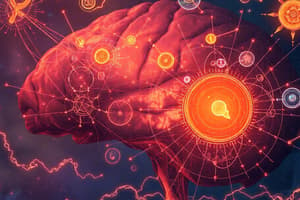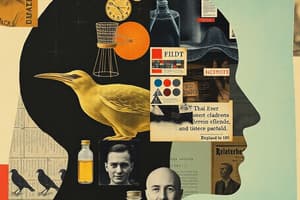Podcast
Questions and Answers
What is the purpose of the scientific method in psychology?
What is the purpose of the scientific method in psychology?
- To ensure subjective interpretations of data
- To increase participant response rates in surveys
- To simplify complex behaviors into quantifiable data
- To remove researcher bias and create a repeatable process (correct)
What primary function do glial cells serve in the nervous system?
What primary function do glial cells serve in the nervous system?
- Generate electrical impulses
- Regulate hormone levels
- Provide insulation and remove waste products (correct)
- Transmit signals between neurons
What is the role of agonists in neurotransmitter activity?
What is the role of agonists in neurotransmitter activity?
- They inhibit neurotransmitter release
- They enhance the activity of neurotransmitters (correct)
- They decrease neuronal firing rates
- They block receptor sites on neurons
Which stage of sleep is characterized by dreaming?
Which stage of sleep is characterized by dreaming?
What does a zero correlation coefficient indicate?
What does a zero correlation coefficient indicate?
What is transduction in sensory processing?
What is transduction in sensory processing?
What is the primary component of social desirability bias?
What is the primary component of social desirability bias?
What physiological response is commonly associated with the limbic system during emotional experiences?
What physiological response is commonly associated with the limbic system during emotional experiences?
What is a spurious correlation?
What is a spurious correlation?
What leads to social loafing?
What leads to social loafing?
What is the range of wavelengths of light that humans can perceive?
What is the range of wavelengths of light that humans can perceive?
Which component of classical conditioning represents an unconditioned response?
Which component of classical conditioning represents an unconditioned response?
What is a defining characteristic of gray matter in the brain?
What is a defining characteristic of gray matter in the brain?
Which theory describes simultaneous processing of physiological arousal and emotion?
Which theory describes simultaneous processing of physiological arousal and emotion?
What numerical value represents a weak correlation coefficient?
What numerical value represents a weak correlation coefficient?
What does amplitude tell us about light and sound?
What does amplitude tell us about light and sound?
What is the role of feature detector cells in the brain?
What is the role of feature detector cells in the brain?
How does an fMRI measure brain activity?
How does an fMRI measure brain activity?
What is a key focus of Gestalt psychologists?
What is a key focus of Gestalt psychologists?
What characterizes a positive correlation between two variables?
What characterizes a positive correlation between two variables?
Which part of the neuron is responsible for conducting electrical impulses away from the cell body?
Which part of the neuron is responsible for conducting electrical impulses away from the cell body?
What distinguishes the opponent-process theory from the trichromatic theory of color vision?
What distinguishes the opponent-process theory from the trichromatic theory of color vision?
What can result from damage to the somatosensory cortex?
What can result from damage to the somatosensory cortex?
What does neuroplasticity refer to?
What does neuroplasticity refer to?
Flashcards
Why do we use the scientific method?
Why do we use the scientific method?
The scientific method reduces bias and ensures consistent results by providing a repeatable process for testing hypotheses.
What is psychology?
What is psychology?
Psychology is the scientific study of human behavior and mental processes.
Agonist vs. Antagonist?
Agonist vs. Antagonist?
An agonist enhances the activity of a neurotransmitter, while an antagonist reduces its activity.
What is Multiple Sclerosis?
What is Multiple Sclerosis?
Signup and view all the flashcards
Name the structures of the limbic system.
Name the structures of the limbic system.
Signup and view all the flashcards
Brain's blood supply
Brain's blood supply
Signup and view all the flashcards
Glial cell function
Glial cell function
Signup and view all the flashcards
What is social desirability bias?
What is social desirability bias?
Signup and view all the flashcards
What is a schema?
What is a schema?
Signup and view all the flashcards
What is the purpose of feature detector cells?
What is the purpose of feature detector cells?
Signup and view all the flashcards
How does an fMRI function?
How does an fMRI function?
Signup and view all the flashcards
What do Gestalt psychologists focus on?
What do Gestalt psychologists focus on?
Signup and view all the flashcards
What is the difference between positive and negative correlation?
What is the difference between positive and negative correlation?
Signup and view all the flashcards
What are the parts of a neuron and their functions?
What are the parts of a neuron and their functions?
Signup and view all the flashcards
What is neuroplasticity?
What is neuroplasticity?
Signup and view all the flashcards
Which sense does not pass through the thalamus?
Which sense does not pass through the thalamus?
Signup and view all the flashcards
What is a spurious correlation?
What is a spurious correlation?
Signup and view all the flashcards
What is the bystander effect?
What is the bystander effect?
Signup and view all the flashcards
What are the components of classical conditioning?
What are the components of classical conditioning?
Signup and view all the flashcards
What range of wavelengths can humans perceive?
What range of wavelengths can humans perceive?
Signup and view all the flashcards
What is the Cannon-Bard Theory of emotion?
What is the Cannon-Bard Theory of emotion?
Signup and view all the flashcards
What does a correlation coefficient tell us?
What does a correlation coefficient tell us?
Signup and view all the flashcards
Study Notes
Scientific Method in Psychology
- Researchers use the scientific method to minimize bias and ensure repeatable processes for verifying reliability.
Psychology Definition
- Psychology is the scientific study of human behavior and mental processes.
Multiple Sclerosis
- Multiple sclerosis involves the deterioration of the myelin sheath.
Agonists and Antagonists
- Agonists increase neurotransmitter activity.
- Antagonists decrease neurotransmitter activity.
Stages of Sleep
- Stage 1: Hypnagogic twitching
- Stage 2: Sleep spindles and delta waves.
- Stage 3: Deep sleep, Delta waves.
- Stage 4: REM sleep and dreaming.
Limbic System Structures
- The limbic system includes the amygdala, hypothalamus, and hippocampus.
Linear Perspective
- Parallel lines appear to converge as they recede into the distance, a depth perception cue.
Brain Blood Supply
- The brain uses about 20% of the body's blood supply.
Glial Cell Functions
- Glial cells support neurons by insulating them, removing waste, and strengthening neural connections.
Neuron Firing Rate
- A neuron's firing rate without the volley principle is 1,000 times per second. With the volley principle, it's 5,000 times per second.
Neuron Types
- Motor neurons, sensory neurons, and interneurons are the three main types of neurons.
Social Desirability Bias
- Social desirability bias is a response tendency where survey respondents answer questions in ways they perceive will be favorably viewed by others.
Components of Emotion
- Emotion comprises cognitive, behavioral, and physiological components.
Correlation Coefficient (Zero)
- A zero correlation coefficient indicates no relationship between two variables.
Accommodation
- Accommodation is focusing light waves from different distances onto the retina.
Sensory Adaptation
- Sensory adaptation allows detection of environmental changes while ignoring consistent stimuli.
Sensory Transduction
- Transduction converts sensory information into electrical impulses.
Placebo Effect Neurotransmitter
- Endorphins are the neurotransmitter associated with the placebo effect.
Dreams' Emotional Content
- Dreams are often high in emotional content because the frontal lobe (responsible for rational thought) is less active. Whereas the limbic system (emotional center) is very active.
Schemas
- Schemas are thought and behavior patterns that categorize information and relationships.
Feature Detector Cells
- Feature detector cells identify elementary visual features which are reassembled into a whole image by the brain.
fMRI Function
- fMRI measures oxygen use in the brain, providing a measure of brain activity.
Gestalt Psychology
- Gestalt psychology focuses on how the brain organizes visual input into meaningful wholes.
Correlation Types
- Positive correlation: both variables increase or decrease together.
- Negative correlation: one variable increases as the other decreases.
Neuron Parts
- Dendrites receive information.
- Cell body (soma): processes information.
- Axon carries impulses.
- Axon terminals: signal to other neurons.
- Myelin sheath speeds up signal transmission.
Color Vision Theories
- Trichromatic theory: three types of cones detect blue, green, and red. Opponent-process theory: opposing color pairings (e.g., red-green).
Somatosensory Cortex Damage
- Damage to the somatosensory cortex can lead to phantom limb pain.
Sociocultural Perspective
- A sociocultural perspective considers how culture and family influence behavior.
Neuron Electrical Impulse
- Excitatory input must outweigh inhibitory input to generate an electrical impulse.
Neuroplasticity
- The nervous system's ability to change structure and function in response to stimuli.
Non-Thalamic Sense
- Olfactory (smell) is the only sense that does not directly pass through the thalamus.
Spurious Correlation
- Spurious correlations occur when cause-and-effect relationships are mistakenly perceived between two variables due to a third, unobserved variable.
Bystander Effect
- The bystander effect occurs when individuals are less likely to help a victim when others are present.
Nearsightedness Risk
- Nearsightedness is linked to retinal detachment, cataracts and glaucoma.
Classical Conditioning
- Classical conditioning involves UCS, CS, NS, CR, and UCR.
Brain Intelligence
- More intelligent people might have more folds and a higher glial-to-neuron ratio in their brains.
Correlation Coefficient Values
- A correlation coefficient close to +1 or −1 indicates a strong correlation; closer to 0 indicates a weak correlation.
Waveform Components
- Waveforms have frequency, amplitude, and wavelength components that correlate with brightness, loudness, and pitch respectively.
Descriptive Methods
- Observational techniques, case studies, and surveys are descriptive research methods.
Brain Matter Differences
- White matter is myelinated; gray matter is unmyelinated.
Emotion Theories
- Cannon-Bard theory proposes simultaneous physiological and emotional responses to a stimulus.
- James-Lange theory suggests physiological arousal precedes emotional experience.
- Schachter-Singer theory introduces cognitive appraisal as a crucial component in emotion experiences.
Social Loafing
- Social loafing is a phenomenon where individuals exert less effort in a group than when working alone.
Conditioning Types
- Delayed conditioning is a particularly effective type.
Auditory Processing
- Low frequency sounds are processed near the front; high near the rear.
Sleep Deprivation Effects
- Sleep deprivation can cause immune suppression, weight gain, accidents, and cognitive impairments.
Studying That Suits You
Use AI to generate personalized quizzes and flashcards to suit your learning preferences.




